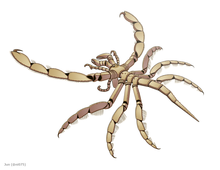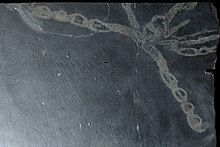Palaeoisopus
| Palaeoisopus Temporal range:
| |
|---|---|

| |
| Fossil | |

| |
| Reconstruction | |
| Scientific classification | |
| Kingdom: | |
| Phylum: | |
| Subphylum: | |
| Class: | |
| Order: | †Palaeoisopoda
|
| Family: | †Palaeoisopodidae Dubinin, 1957
|
| Genus: | †Palaeoisopus |
| Species: | †P. problematicus
|
| Binomial name | |
| †Palaeoisopus problematicus Broili, 1928
| |
Palaeoisopus is a genus of fossil pycnogonid (sea spider). The only known species is Palaeoisopus problematicus from the Lower Devonian Hunsrück Slate of Germany. It is characterized by several features unusual for a pycnogonid, such as swimming legs of different sizes and a long, segmented abdomen.[2][3]
Discovery
[edit]Palaeoisopus is the most common pycnogonid of Hunsrück Slate, with over 80 fossil specimens had been discovered as of 2024.[3]
When this arthropod was first described by Broili 1928,[1] it was thought to be an isopod crustacean, hence the name Palaeoisopus.[3] A few years later, it was re-identified as a pycnogonid by the same author.[4] Even so, the anterior and posterior axis was reversed, with the overlapped chelifores and long abdomen being misinterpreted as a round abdomen and an elongated cephalon (head), respectively. This was corrected by Lehmann 1959, which using X-ray to identify cephalic structures such as ovigers and ocular tubercles between the "abdomen" (chelifores) and "fourth legs" (first legs).[5] Bergström et al. 1980 using the same method to study more specimens, providing a detailed reconstruction of Palaeoisopus.[2] Sabroux et al. 2024 redescribed this genus alongside other Hunsrück pycnogonid fossils, by using both X-ray and RTI method they discover some new details, mostly those of the cephalic structures.[3]
Morphology
[edit]

-
Main body
-
Chelifores, palps and ovigers
Palaeoisopus is a large pycnogonid, with a body length (excluding proboscis and chelifores) of at least 12.5 cm and leg spans of up to 40 cm, comparable to a modern Colossendeis (giant sea spider).[2][3]
The margin of its exoskeleton are ornamented with tubercles. The body is widest at the box-shaped cephalon, with a cylinderal proboscis folded underneath it. The succeeding 3 trunk segments have pairs of dorsal tubercle and narrow towards the long abdomen. The abdomen apparently compose of 4 flexible segments and a styliform (sword-like) telson,[6][3] but based on the medial position of anus (which, in telson-bearing chelicerates, always located at the ventral boundary of abdomen and telson), the latter was also suggest to be a fusion of fifth abdominal segment and the original telson.[2]
There is a dorsal ocular tubercle at the front of its cephalon. In the classical reconstruction by Lehmann 1959 and Bergström et al. 1980, it compose of a pair of large eyes and 2 smaller eyes arranged in a midline, unlike the 2-paired ocelli of other pycnogonids.[2] In the redescription by Sabroux et al. 2024, it was re-interpreted as having no eyes, with the purported eye-like structures representing either just tubercles or lateral sense organs.[3]
The first appendages are a pair of robust, pincer-like chelifores in front of the cephalon. Based on Bergström et al. 1980, each chelifore compose of 5 segments (podomere): 3 for scape and 2 for pincer, instead of 3 or 4 (1 or 2 for scape and 2 for pincer) like those of the other pycnogonids.[7] This was questioned by Sabroux et al. 2024, as the putative "second and third scape segment" might be just a second scape segment with an additional midway ridge.[3] The palps and ovigers located laterally and lateroventrally to the anterior cephalic region, respectively. Each apparently have more segments (11 and 12) than those of other pycnogonids (up to 9 and 10), but their 3 basal "segments" might represent annulations of a subdivided first segment (coxa 1) as seen in the legs. The palps have a spur on its fourth distalmost segments and the ovigers terminted by a claw. The ovigers were apparently absent in some specimens, which may represent sexual dimorphism as seen in some modern pycnogonid taxa[2] such as Pycnogonidae and Phoxichilidiidae (female lacking ovigers).[8][9]
The remaining appendages are 4 pairs of enormous legs. Unlike other pycnogonids with subequal legs, each pair of them are different in sizes (smaller towards the posterior). The base was surrounded by multiple ring-like annulations (4 for leg 1, 3 for leg 2, 2 for leg 3-4) that represent coxa 1, connected to the short lateral processes of cephalon and trunk. The distal section (beyond the fourth segment/femur, which is unusually short for a pycnogonid) was flatten, lined with marginal setae and terminated by a robust, hook-like claw. The first legs are distinctive: they have significantly widen coxae, their flatten distal section compose of 4 segments with subequal width and bore a few ventral setae at each of their distal corner. In comparison, the second to fourth legs have 5 flatten distal segments that narrow towards the end and possess double rows of long ventral setae.[2][3]
Paleoecology
[edit]
Palaeoisopus may had been a nektonic pycnogonid that swimming aroud the sea floor by moving its oar-like legs.[2][3] The robust chelifores and hooked claws suggest it was a predator. Based on the purported large eyes, Bergström et al. 1980 suggest it rely on visual cues to find preys, with associated stalked crinoid (sea lily) as a possible target.[2] This was questioned by Sabroux et al. 2024, as they re-interpreted it as blind and the association with crinoid was limited only to juvenile specimens.[3]
Taxonomy
[edit]
Paleosiopus may had been a basal, stem-group pycnogonid,[2][10][11] as its long, segmented abdomen and telson likely represent an ancestral traits, suggesting it branched off before the pycnogonid stem lineage started to reduce the abdomen into a short, unsegmented tubercle.[2][12] There are some other Paleozoic pycnogonids with similar leg morphology to this genus (possess annulated coxa 1, flatten distal segments, marginal setae, hooked claws and first leg pair with 1 less segment) such as the older Haliestes and coexisting Pentapantopus, but it is unknown if this leg type represent a clade or evolutionary grade of pycnogonid stem-group.[3] While some analysis placing them within Pantopoda (crown-group pycnogonids),[13] this result is questionable as they have low support value and based on outdated reconstrution of the fossil taxa.[14][15][3]
References
[edit]- ^ a b Broili, F. (1928). "Crustaceenfunfe aus dem rheinischen Unterdevon". Sitzungsberichte der mathematisch-naturwissenschaftlichen Abteilung der Bayerischen Akademie der Wissenschaften zu München 1928: 197–201.
- ^ a b c d e f g h i j k Bergström, Jan; Stürmer, Wilhelm; Winter, Gerhard (1980-06-01). "Palaeoisopus, Palaeopantopus and Palaeothea, pycnogonid arthropods from the Lower Devonian Hunsrück Slate, West Germany". Paläontologische Zeitschrift. 54 (1–2): 7–54. doi:10.1007/BF02985882. S2CID 86746066.
- ^ a b c d e f g h i j k l m Sabroux, Romain; Garwood, Russell J.; Pisani, Davide; Donoghue, Philip C. J.; Edgecombe, Gregory D. (2024-10-14). "New insights into the Devonian sea spiders of the Hunsrück Slate (Arthropoda: Pycnogonida)". PeerJ. 12: e17766. doi:10.7717/peerj.17766. ISSN 2167-8359. PMC 11485130. PMID 39421419.
- ^ Broili, F. (1932). "Palaeoisopus ist ein Pantopode". Sitzungsberichte der mathematisch-naturwissenschaftlichen Abteilung der Bayerischen Akademie der Wissenschaften zu München. 2: 45–60.
- ^ Lehmann, W. M. (1959). "Neue Entdeckungen an Palaeoisopus". Paläontologische Zeitschrift (in German). 33 (1): 96–103. doi:10.1007/BF02988981. ISSN 1867-6812.
- ^ Dunlop, Jason A.; Lamsdell, James C. (2017). "Segmentation and tagmosis in Chelicerata". Arthropod Structure & Development. 46 (3): 395–418. doi:10.1016/j.asd.2016.05.002. PMID 27240897.
- ^ Brenneis, Georg; Arango, Claudia P. (December 2019). "First description of epimorphic development in Antarctic Pallenopsidae (Arthropoda, Pycnogonida) with insights into the evolution of the four-articled sea spider cheliphore". Zoological Letters. 5 (1): 4. doi:10.1186/s40851-018-0118-7. PMC 6330760. PMID 30656062.
- ^ Bain, Bonnie A.; Govedich, Fredric R. (December 2004). "Courtship and mating behavior in the Pycnogonida (Chelicerata: Class Pycnogonida): a summary". Invertebrate Reproduction & Development. 46 (1): 63–79. doi:10.1080/07924259.2004.9652607. S2CID 84993360.
- ^ Ballesteros, Jesús A.; Setton, Emily V. W.; López, Carlos E. Santibáñez; Arango, Claudia P.; Brenneis, Georg; Brix, Saskia; Cano-Sánchez, Esperanza; Dandouch, Merai; Dilly, Geoffrey F.; Eleaume, Marc P.; Gainett, Guilherme (2020-02-02). "Phylogenomic resolution of sea spider diversification through integration of multiple data classes". bioRxiv. 38 (2): 686–701. doi:10.1101/2020.01.31.929612. PMC 7826184. PMID 32915961. S2CID 213417127.
- ^ Siveter, Derek J.; Sutton, Mark D.; Briggs, Derek E. G.; Siveter, David J. (October 2004). "A Silurian sea spider". Nature. 431 (7011): 978–980. doi:10.1038/nature02928. PMID 15496921. S2CID 4420863.
- ^ Poschmann, Markus; Dunlop, Jason A. (2006). "A new sea spider (Arthropoda: Pycnogonida) with a flagelliform telson from the Lower Devonian Hunsrück Slate, Germany". Palaeontology. 49 (5): 983–989. doi:10.1111/j.1475-4983.2006.00583.x.
- ^ Kühl, Gabriele; Poschmann, Markus; Rust, Jes (May 2013). "A ten-legged sea spider (Arthropoda: Pycnogonida) from the Lower Devonian Hunsrück Slate (Germany)". Geological Magazine. 150 (3): 556–564. doi:10.1017/S0016756812001033. S2CID 129801458.
- ^ Arango, Claudia P.; Wheeler, Ward C. (June 2007). "Phylogeny of the sea spiders (Arthropoda, Pycnogonida) based on direct optimization of six loci and morphology". Cladistics. 23 (3): 255–293. doi:10.1111/j.1096-0031.2007.00143.x. PMID 34905863. S2CID 84031914.
- ^ Brenneis, Georg; Scholtz, Gerhard (2014-04-15). "The 'Ventral Organs' of Pycnogonida (Arthropoda) Are Neurogenic Niches of Late Embryonic and Post-Embryonic Nervous System Development". PLOS ONE. 9 (4): e95435. doi:10.1371/journal.pone.0095435. ISSN 1932-6203. PMC 3988247. PMID 24736377.
- ^ Siveter, Derek J.; Sabroux, Romain; Briggs, Derek E. G.; Siveter, David J.; Sutton, Mark D. (2023). "Newly discovered morphology of the Silurian sea spider Haliestes and its implications". Papers in Palaeontology. 9 (5): e1528. doi:10.1002/spp2.1528. hdl:1983/267d44cb-bd22-4a1d-9d00-b3916c453784. ISSN 2056-2802.


